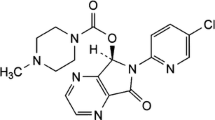Abstract
Purpose. To prepare amorphous quinapril hydrochloride(QHCl) by lyophilization and to compare its physical characteristics andchemical stability as a function of the initial pH of the pre-lyophilizedsolution.
Methods. Amorphous QHCl samples were prepared bylyophilization from aqueous solutions. Solid-state characteristics wereevaluated by DSC, PXRD, and optical microscopy. Chemical degradation wasmonitored by an HPLC assay.
Results. Amorphous QHCl samples obtained fromlyophilization exhibited variable glass transition temperatures, dependingon the pH and/or concentration of the starting aqueous solutions.Neutralized quinapril (Q) in the amorphous form, which has a Tgof 51°C, lower than that of its HCl salt (91°C), was significantlymore reactive than QHCl at the same temperature. The Tg oflyophilized samples prepared at various initial pH values correlated wellwith values predicted for mixtures of QHCl and Q. Their different reactionrates were related to their glass transition temperature, consistent withthe results from earlier studies obtained with amorphous samples made byprecipitation from an organic solution and grinding of the crystalsolvate.
Conclusions. Lyophilization of different QHCl solutionsproduces mixtures of amorphous QHCl and its neutralized form Q, withTg values intermediate to the values of QHCl and Q. As thefraction of Q increases the overall rate of chemical degradation increasesrelative to QHCl alone, primarily due to the increase in molecular mobilityinduced by the plasticizing effects of Q.
Similar content being viewed by others
REFERENCES
Y. Guo, S. R. Byrn, and G. Zografi. Physical characteristics and chemical degradation of amorphous quinapril hydrochloride. J. Pharm. Sci. 89:128–143 (2000).
S. Klutchko, C. J. Blankley, R. W. Fleming, J. M. Hinkley, A. E. Werner, I. Nordin, A. Holmes, M. L. Hoefle, D. M. Cohen, A. D. Essenburg, and H. R. Kaplan. Synthesis of novel angiotensin converting enzyme inhibitor quinapril and related compounds. A divergence of structure-activity relationships for non-sulfhydryl and sulfhydryl types. J. Med. Chem. 29:1953–1961 (1986).
R. G. Strickley, G. C. Visor, L. Lin, and L. Gu. An unexpected pH effect on the stability of moexipril lyophilized powder. Pharm. Res. 6:971–975 (1989).
M. Gordon and J. S. Taylor. Ideal copolymers and the second-order transitions of synthetic rubbers. I. Non-crystalline copolymers. J. Applied Chem. 2:493–500 (1952).
R. Simha and R. F. Boyer. On a general relation involving the glass temperature and coefficient of expansion of polymers. J. Chem. Phys. 37:1003–1007 (1962).
P. R. Couchman and F. E. Karasz. A classical thermodynamic discussion on the effect of composition on glass-transition temperatures. Macromolecules 11:117–119 (1978).
R. Bohmer, K. L. Ngai, C. A. Angell, and D. J. Plazek. Nonexponential relaxations in strong and fragile glass formers. J. Chem. Phys. 99:4201–4209 (1993).
C. T. Moynihan, A. J. Easted, J. Wilder, and J. Tucker. Dependence of glass transition temperature on heating and cooling rate. J. Phys. Chem. 78:2673–2677 (1974).
P. G. Jönsson and Å. Kvick. Precision neutron diffraction structure determination of protein and nucleic acid compounds. III. The crystal and molecular structure of the amino acid a-glycine. Acta Cryst. Section B 28:1827–1833 (1972).
Author information
Authors and Affiliations
Rights and permissions
About this article
Cite this article
Guo, Y., Byrn, S.R. & Zografi, G. Effects of Lyophilization on the Physical Characteristics and Chemical Stability of Amorphous Quinapril Hydrochloride. Pharm Res 17, 930–936 (2000). https://doi.org/10.1023/A:1007519003070
Issue Date:
DOI: https://doi.org/10.1023/A:1007519003070




